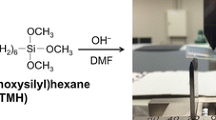Abstract
Transparent films with a thickness of more than 100 μm of phenylsilsesquioxane (PhSiO3/2) were prepared via thermal softening of PhSiO3/2 gel, which was obtained by a two-step acid-base catalyzed sol–gel process. The gel was applied to a substrate and subjected to a heat treatment at 200 °C, which resulted in the thermal softening of the gel and the attainment of fluidity. Upon cooling to ambient temperature, transparent films were obtained. The hardness of the films was slightly increased through the addition of colloidal silica in the preparation of PhSiO3/2 gel, which was also synthesized via a two-step acid-base catalyzed sol–gel process. The resulting gel containing colloidal silica also displayed fluidity upon heating, and crack-free films were obtained in a larger-thickness region with the addition of SiO2 filler.
Graphical Abstract

Highlights
-
Transparent films with a thickness of more than 100 μm of phenylsilsesquioxane (PhSiO3/2) were prepared via thermal softening of PhSiO3/2 gel.
-
PhSiO3/2 gel was obtained by a two-step acid-base catalyzed sol–gel process.
-
The formation process of the thick films is basically the same as that of the ceramic glazes.
-
The hardness of the films was increased through the addition of colloidal silica.





Similar content being viewed by others
References
Pradell T, Molera J (2020) Ceramic technology. How to characterize ceramic glazes. Archaeol Anthropol Sci 12:189. https://doi.org/10.1007/s12520-020-01136-9
Toide T, Rosero-Navarro NC, Miura A, Kozuka H, Tadanaga K (2022) Preparation of transparent and mechanically hard inorganic-organic hybrid thick films from 3-glycidoxypropyltrimethoxysilane and zirconium propoxide. J Sol Gel Sci Technol 104:478–483. https://doi.org/10.1007/s10971-022-05836-7
Baney RH, Itoh M, Sakakibara A, Suzuki T (1995) Silsesquioxanes. Chem Rev 95:1409–1430. https://doi.org/10.1021/cr00037a012
Loy DA, Baugher BM, Baugher CR, Schneider DA, Rahimian K (2000) Substituent effects on the sol–gel chemistry of organotrialkoxysilanes. Chem Mater 12:3624–3632
Cordes DB, Lickiss PD, Rataboul F (2010) Recent developments in the chemistry of cubic polyhedral oligosilsesquioxanes. Chem Rev 110:2081–2173. https://doi.org/10.1021/cr900201r
Choi JY, Kim CH, Kim DK (1998) Formation and characterization of monodisperse, spherical organo-silica powders from organo-alkoxysilane-water system. J Am Ceram Soc 81:1184–1188. https://doi.org/10.1111/j.1151-2916.1998.tb02466.x
Ma C, Kimura Y (2002) Preparation of nanoparticles of poly(phenylsilsesquioxane)s by emulsion polycondensation of phenylsilanetriol formed in aqueous solution. Polym J 34:709–713. https://doi.org/10.1295/polymj.34.709
Arkhireeva A, Hay JN (2003) Synthesis of sub-200 nm silsesquioxane particles using a modified Stöber sol–gel route. J Mater Chem 13:3122–3127. https://doi.org/10.1039/B306994J
Choi SS, Lee AS, Hwang SS, Baek KY (2015) Structural control of fully condensed polysilsesquioxanes: ladderlike vs cage structured polyphenylsilsesquioxanes. Macromolecules 48:6063–6070. https://doi.org/10.1021/acs.macromol.5b01539
Lee AS, Choi SS, Baek KY, Hwang SS (2016) Hydrolysis kinetics of a sol-gel equilibrium yielding ladder-like polysilsesquioxanes. Inorg Chem Commun 73:7–11. https://doi.org/10.1016/j.inoche.2016.09.004
Matsuda A, Sasaki T, Hasegawa K, Tatsumisago M, Mianmi T (2000) Thermal softening behavior of poly (phenylsilsesquioxane) and poly (benzylsilsesquioxane) particles. J Ceram Soc Jpn 108:830–835. https://doi.org/10.2109/jcersj.108.1261_830
Katagiri K, Hasegawa K, Matsuda A, Tatsumisago M, Minami T (1998) Preparation of transparent thick films by electrophoretic sol-gel deposition using phenyltriethoxysilane-derived particles. J Am Ceram Soc 81:2501–2503. https://doi.org/10.1111/j.1151-2916.1998.tb02653.x
Takahashi K, Tadanaga K, Hayashi A, Matsuda A, Tatsumisago M (2008) Glass transition and thermal softening of poly(phenylsilsesquioxane) particles prepared using two-step acid-base catalyzed sol-gel process. J Non Cryst Solids 354:700–704. https://doi.org/10.1016/j.jnoncrysol.2007.07.073
Macan J, Tadanaga K, Tatsumisago M (2010) Influence of copolymerization with alkyltrialkoxysilanes on condensation and thermal behaviour of poly(phenylsilsesquioxane) particles. J Sol Gel Sci Technol 53:31–37. https://doi.org/10.1007/s10971-009-2051-x
Aparicio M, Jitianu A, Rodriguez G, Degnah A, Al-Marzoki K, Mosa J, Klein LC (2016) Corrosion protection of AISI 304 stainless steel with melting gel coatings. Electrochim Acta 202:325–332. https://doi.org/10.1016/j.electacta.2015.12.142
Klein LC, Kallontzi S, Fabris L, Jitianu A, Ryan C, Aparicio M, Lei L, Singer JP (2019) Applications of melting gels. J Sol Gel Sci Technol 89:66–77. https://doi.org/10.1007/s10971-018-4599-9
Acknowledgements
The present study was partly supported by JST A-STEP Grant Number JPMJTM19AH.
Author information
Authors and Affiliations
Contributions
KT wrote the main manuscript. YI carried out the experiments and prepared all figures. NCR-N and AM supported the experimental work, and discussed with KT and YI through this research. All authors reviewed the manuscript.
Corresponding author
Ethics declarations
Conflict of interest
The authors declare no competing interests.
Additional information
Publisher’s note Springer Nature remains neutral with regard to jurisdictional claims in published maps and institutional affiliations.
Rights and permissions
Springer Nature or its licensor (e.g. a society or other partner) holds exclusive rights to this article under a publishing agreement with the author(s) or other rightsholder(s); author self-archiving of the accepted manuscript version of this article is solely governed by the terms of such publishing agreement and applicable law.
About this article
Cite this article
Tadanaga, K., Inoue, Y., Rosero-Navarro, N.C. et al. Preparation of phenylsilsesquioxane thick films using thermal softening behavior. J Sol-Gel Sci Technol (2024). https://doi.org/10.1007/s10971-024-06332-w
Received:
Accepted:
Published:
DOI: https://doi.org/10.1007/s10971-024-06332-w




